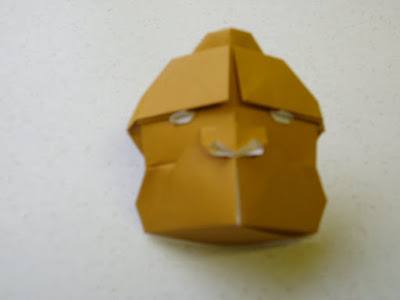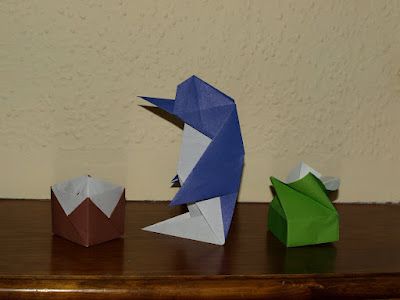skip to main |
skip to sidebar









 After the baptism-of-fire of Ted Norminton's more advanced folding, I decided my next major project would be to work through another book by Kunihiko Kasahara. This time, it's his "Origami Omnibus", which has been recommended on many of the Origami websites I've scanned. The photos I've uploaded here are mostly from the first main section, which concerns masks of various kinds. One or two of the photos are a bit blurry, because I folded all the masks from 15cm paper, which meant some of the masks turned out very small. The masks are, in order: Celestial General, Gorilla, Kamui, Lion (Male) Mane, Monster from the Arabian Nights, and Tengu. Next come a couple of modular figures (my first foray into this area, which looks fascinating, and will appeal to my mathematical tendencies): Jumbo Unit Spinning Top (2 views) and Multiunit Decorative Sphere. Finally, there's a photo of the very first model in Tomoko Fuse's classic "Unit Origami" book. When I eventually finish with "Origami Omnibus", Fuse's book will be my next project, but I couldn't resist trying just one model from her book, so the last photo in this set is her Cube - Small Square-Pattern Belt Unit. Hope you enjoy some of them.
After the baptism-of-fire of Ted Norminton's more advanced folding, I decided my next major project would be to work through another book by Kunihiko Kasahara. This time, it's his "Origami Omnibus", which has been recommended on many of the Origami websites I've scanned. The photos I've uploaded here are mostly from the first main section, which concerns masks of various kinds. One or two of the photos are a bit blurry, because I folded all the masks from 15cm paper, which meant some of the masks turned out very small. The masks are, in order: Celestial General, Gorilla, Kamui, Lion (Male) Mane, Monster from the Arabian Nights, and Tengu. Next come a couple of modular figures (my first foray into this area, which looks fascinating, and will appeal to my mathematical tendencies): Jumbo Unit Spinning Top (2 views) and Multiunit Decorative Sphere. Finally, there's a photo of the very first model in Tomoko Fuse's classic "Unit Origami" book. When I eventually finish with "Origami Omnibus", Fuse's book will be my next project, but I couldn't resist trying just one model from her book, so the last photo in this set is her Cube - Small Square-Pattern Belt Unit. Hope you enjoy some of them.



 For those idle moments during this year's annual holiday in Cornwall, I took along a pack of paper and the two booklets of folds by Ted Norminton from the British Origami Society. "Sink Or Swim" was tough enough, but "Petal Folds and More" made me feel as if my fingers were breaking and my brain melting. Still, I managed a half-reasonable stab at several of the figures, and Janet took the photographic evidence. I left the figures on the bookshelves at our holiday cottage for the next occupants to discover. Wonder if they realised the toil and torment that went into them?
For those idle moments during this year's annual holiday in Cornwall, I took along a pack of paper and the two booklets of folds by Ted Norminton from the British Origami Society. "Sink Or Swim" was tough enough, but "Petal Folds and More" made me feel as if my fingers were breaking and my brain melting. Still, I managed a half-reasonable stab at several of the figures, and Janet took the photographic evidence. I left the figures on the bookshelves at our holiday cottage for the next occupants to discover. Wonder if they realised the toil and torment that went into them?
One recurring problem I had with Ted's creations was the whole area of sinks.It gradually dawned on me that I'd not really grasped the distinction between open sinks and closed sinks - let alone such niceties as half-closed sinks, and closed/open unsinks. Time and again, the next step in a diagram would show the figure-in-progress with four pouch-like pockets arranged radially, whereas I had eight separate vanes flapping about. After the holiday, I did some serious Googling on the subject of sinks, and spent several evenings just practising putting closed and open sinks into a waterbomb base until I started to understand the distinction from a geometric point of view, as well as from a practical point of view. I was horrified to learn that a closed sink often inevitably involves making quite a mess of part of the model, and then tidying it up. I'd been thinking of Origami as always very neat and precise, but obviously I need to learn to be unafraid to allow things to get messy sometimes.


 Here are three more animals from Kunihiko Kasahara's book, Origami Made Easy. All were folded using 15cm Muji kami paper. The fox was folded from a single sheet, whilst Nessie and the Giant Panda used two sheets each. I'm still paddling in the shallows here, but at least I now know (thanks to some advice from my photographer wife) about putting some draping material behind the figures! I also know to use ambient light and a tripod, rather than flash, since flash tends to wash out detail. Only a few more figures left to try in Origami Made Easy, and then I'll be moving on to Kasahara's Origami Omnibus, which I believe includes a few more intermediate-level figures. Hope my fingers are up to it! Incidentally, one small improvement in my folding technique this time, came from an Origami FAQ I found via Google, which made me realise I'd been concentrating on moving points to points, rather than focussing on the crease line itself. This small adjustment in emphasis does seem to have improved my accuracy a bit. The same FAQ also recommended only sharpening creases when you reach a "resting point", rather than at each intermediate step in a folding diagram. My lack of confidence as a folder (from inexperience) still makes me want to "nail" each step in a diagram before moving to the next, to the point where I'm nearly wearing down the back of my left thumbnail, but I'm trying to resist the temptation to make every crease knife-sharp before moving to the next sub-step! Anyway, I hope you enjoy the pictures!
Here are three more animals from Kunihiko Kasahara's book, Origami Made Easy. All were folded using 15cm Muji kami paper. The fox was folded from a single sheet, whilst Nessie and the Giant Panda used two sheets each. I'm still paddling in the shallows here, but at least I now know (thanks to some advice from my photographer wife) about putting some draping material behind the figures! I also know to use ambient light and a tripod, rather than flash, since flash tends to wash out detail. Only a few more figures left to try in Origami Made Easy, and then I'll be moving on to Kasahara's Origami Omnibus, which I believe includes a few more intermediate-level figures. Hope my fingers are up to it! Incidentally, one small improvement in my folding technique this time, came from an Origami FAQ I found via Google, which made me realise I'd been concentrating on moving points to points, rather than focussing on the crease line itself. This small adjustment in emphasis does seem to have improved my accuracy a bit. The same FAQ also recommended only sharpening creases when you reach a "resting point", rather than at each intermediate step in a folding diagram. My lack of confidence as a folder (from inexperience) still makes me want to "nail" each step in a diagram before moving to the next, to the point where I'm nearly wearing down the back of my left thumbnail, but I'm trying to resist the temptation to make every crease knife-sharp before moving to the next sub-step! Anyway, I hope you enjoy the pictures!

 For some reason, Blogger only let me upload 5 images at a time, so here are the rest of them.
For some reason, Blogger only let me upload 5 images at a time, so here are the rest of them.




 I first encountered Origami in my early teens, when I found, in the local library, a copy of Samuel Randlett's "The Art Of Origami". I was pretty impatient (and therefore clumsy) back then, at the start of the 70s, and I had to cut my own squares from scrap paper, but I was fascinated by the assorted bases and the boundless variety of shapes that sprang forth from them. Or as far as my cack-handed fumblings could approximate, anyway.
I first encountered Origami in my early teens, when I found, in the local library, a copy of Samuel Randlett's "The Art Of Origami". I was pretty impatient (and therefore clumsy) back then, at the start of the 70s, and I had to cut my own squares from scrap paper, but I was fascinated by the assorted bases and the boundless variety of shapes that sprang forth from them. Or as far as my cack-handed fumblings could approximate, anyway.
Like most teenage enthusiasms, the Origami fad waned, and I forgot all about it. Until recently, when I found myself idly flexing a square of paper from the telephone message block. I googled "Randlett", and there was the book. I tried "Origami", and discovered the British Origami Society, and a page where the American Origami fans had voted on their favourite Origami books. Selecting a few of those tagged as suitable for beginners, I ordered a few from Amazon, along with a pack of Origami paper.
As soon as I opened the parcel, the fascination came flooding back. More patient this time, the results were even more satisfying, and using proper Origami "Kami" paper gave them a smarter appearance, too. So I worked my way steadily through Montroll's "Easy Origami" and Sakata's "Origami", which helped me develop some basic familiarity and start to improve my dexterity.
At this point, I decided to join the British Origami Society, and availed myself of their mail order supplies service. Armed with several packs of square paper, I embarked on the next book, a bit more challenging: Kasahara's "Origami Made Easy". This contains some interesting models, some of which I botched badly, and some of which came out, well, not too badly. I've learned that insect legs are one of my major betes noir; the combination of very acute angles and trying to reverse-fold spindly legs which are many paper-layers thick, manages to make me feel like I've ten thumbs, none of which work very well! Neatness and accuracy are clearly something I must continue to work on. Meanwhile, here are a few of my efforts so far from Kasahara's book.

































